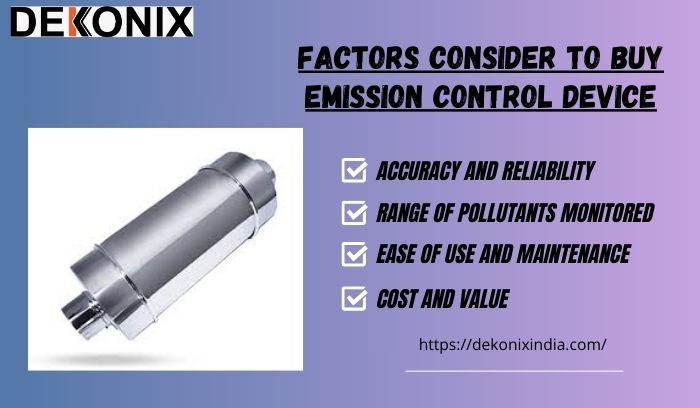
Things To Consider Before Buy Emission Control Device For DG Set
Today, environmental issues are vital because industries are growing. It’s important to think about how our actions affect the environment, especially air pollution from diesel generators. To reduce these effects, emission control devices are a key solution. But before buying one for your diesel generator, consider some important points.
The mechanism that is placed at the opening of the exhaust of a diesel generator to reduce emission is known as a retrofit emission control device. A retrofitted emission control equipment for a DG Set is one of the most beneficial methods to filter out dangerous components like carbon monoxide, sulfur dioxide, diesel particle matter, and nitrogen oxides.
To put it entirely, retrofitting is the process of fixing an emission control device to clear the harmful release of gases from a diesel engine exhaust. A Retrofitted Emission Control device (DG Set RECD) effortlessly takes away over 90% of the particle matter & other impurities from the exhaust of the DG Set. The Central Pollution Control Board (CPCB) makes retrofitted emission control devices compulsory for all vehicles, generators, and fuel-burning engines.
Why is RECD Important For Diesel Generators?
The impurities radiated by an internal combustion engine are monitored by a hydrocarbon fuel but it causes some dangerous health hazards and climate changes. In the shape of smog air pollution was first acknowledged as a danger to public health in the middle of the 20th century. This finding directed to the first emission control rules. Pollution’s long-term effects and its harmful contribution to global warming have become a major problem, producing more international movements and creating advanced emission control systems to meet increased emission measures.
Factors Consider To Buy Emission Control Device
There are many factors to be considered before buying a retrofitted emission control device. In general, they are grouped into 4 types.
- Accuracy and reliability
- The range of pollutants monitored
- Ease of use and maintenance
- Cost and value
Accuracy and Reliability
When evaluating the data grade of separate low-cost device technologies, accuracy and reliability are important factors to take into account. The capacity to which pollution data from the device agree with those from a reference-grade monitor is directed to accuracy. Reliability, on the other hand, refers to how steadily the measure points of the device match one another rather than the reference device.
Exactness and bias are the two factors that affect a device’s accuracy. The exactness of a device is its ability to duplicate a measurement with a reference monitor in the same environmental surroundings. The word bias refers to the degree of measurement inaccuracy in the data, i.e., whether the data are higher or lower than the true concentration.
So, When you look for an air pollution control device for a diesel generator it is important to look at accuracy and reliability. Keep in mind that it will collect High-quality data during the working of the project.
The range of pollutants monitored
During the leadership of the project, it is necessary to select air quality monitoring tools that are skilled in measuring all probable impurities of interest at the ranges that the network desires to notice. Particulate matter and nitrogen dioxide are measured by the Clarity Node-S, and additional modules are available for measuring wind ozone, and other elements of air quality.
The pollutant concentrations that the device may encounter during monitoring can vary widely, so it is also critical that air emission control device technology can detect both high and low concentrations.
Cost and Value
It is important to take into account the buying price of air pollution control machines as well as the long-term working costs of the silent diesel generator. Anyone may collect reliable, high-density air quality data at a fraction of the usual costs thanks to Clarity’s Sensing-as-a-Service architecture, which minimizes the operational expenses related to maintaining an air quality monitoring network. As a result, expanding air quality monitoring networks to dozens, hundreds, or even thousands of measurement sites becomes financially viable.
Think about the data quality and standards that are necessary for your particular air quality monitoring project, including data transfer and storage, calibration services, and so on.
It is important from a logistical standpoint to select equipment based on what the surroundings can offer. Depending on where the device is to be placed, there may be varying power and connectivity requirements.
Ease of Use and Maintenance
When selecting a pollution control device for DG set, ease of use is necessary since a type of user with differing degrees of technical skill and experience may use it. The cost of operating the network may also be impacted by the requirement for a competent technician or different specialist.
A maintenance plan for a diesel generator set includes how long the device will survive, what measurement benefits will be required to be maintained, and how often the equipment has to be replaced or repaired.
Conclusion
From the above study, we can conclude that the retrofit emission control device for DG set is accurate and reliable, with features that are user-friendly and maintained. The firm delivers retrofit emission control technology for a variety of DG sets that fall well inside the Central Pollution Control Board’s (CPCB) authorized conditions. By using cutting-edge machinery users can now upgrade their pollution control devices if they are old and not working. Improving engine life & emission control and reducing the impact of pollution on the environment by using this technology.
